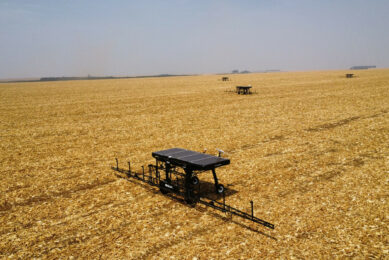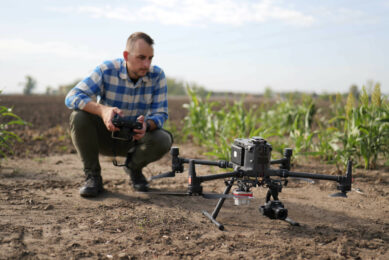Exclusive report: Research reveals how to cut drift from spray-drones

Independent research in the USA reveals how using a swath offset for drone applications and the correct nozzle choice can cut drift to similar levels as a boom sprayer. Mick Roberts reports.
Results from a recent, scientific study reveal a spray drone produces higher levels of airborne spray movement and potential drift compared with a tractor-mounted boom sprayer.
The research shows, however, that off-site spray deposits can be greatly reduced by offsetting the first pass on the downwind edge of the field by one, or more, passes. The studies also prove how larger spray droplets play a significant role in mitigating drift.
For this unique spray drift field study Bayer Crop Science partnered with USDA-ARS Aerial Application Technology Research Unit to conduct the study at the University of Nebraska at North Platte West Central Research and Extension Center in October 2020.
Carried out using 12 repetitions of each treatment, it followed protocols developed with input from the US Environmental Protection Agency and Canada’s Pest Management Regulatory Agency. As such, it is the first scientifically verified research to compare drift between a ground based boom applicator and a drone. The results will help inform decisions about how to best use and regulate pesticide applications to protect both crops and the environment.
Text continues below picture
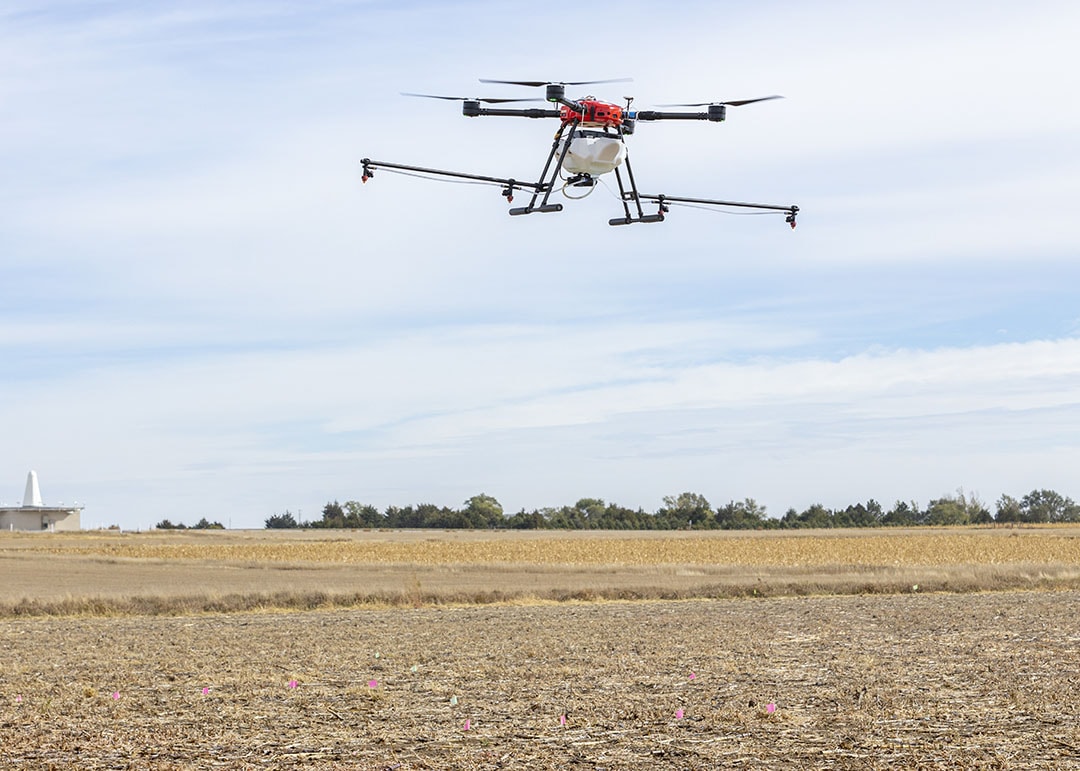
Study objectives
The study’s aim was to characterise drift from a drone compared with that from a ground application – a standard spray boom, explains Dr. Dan Martin, Aerial Application Technology Research Engineer at the USDA.
“Spray solutions released near the ground or crop canopy – commonly at a height of 50-60cm above the target – do not have adequate travel distance or time for evaporation or downwind movement to have a significant effect on drift, if used within label requirements. A drone, however, usually works at an application height of about 2-3m above the crop or ground,” explains Dan.
This is why it is important to compare an application from a drone application with a ground sprayer, to better understand the mechanisms of the sprayer movement and downwind deposition between the two systems.
Testing procedure
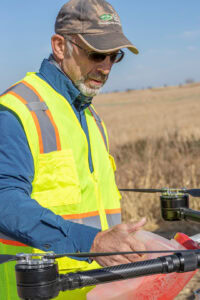
To fully assess the drift, the study used two methods to catch the depositions. Mylar cards were placed on the ground at 0.5m spacings from 7m upwind out to 20m downwind, 5m spacings from 20m to 50m downwind and then at 10m spacings from 50m out to 100m from the edge of the field. Drift towers, using special ‘bottle brushes’ at 0.2m and 2m heights to catch airborne fine droplets were placed at 10m spacings out to 50m.
“We went out to 100m to ensure our study would detect exactly where the drift fell to zero,” explains Dan.
The team also installed two weather stations 2m above the ground, one upwind of the applications and another about 50m downwind of the 100m long sampling line. These monitored wind direction and speed and took readings every second to make three minute averages for each spray pass.
Four treatments were compared with 12 replications, with and without an off-set:
- Drone – Medium nozzles
- Boom – Medium nozzles
- Drone – Extra coarse nozzles
- Boom – Extra coarse nozzles
Text continues below picture
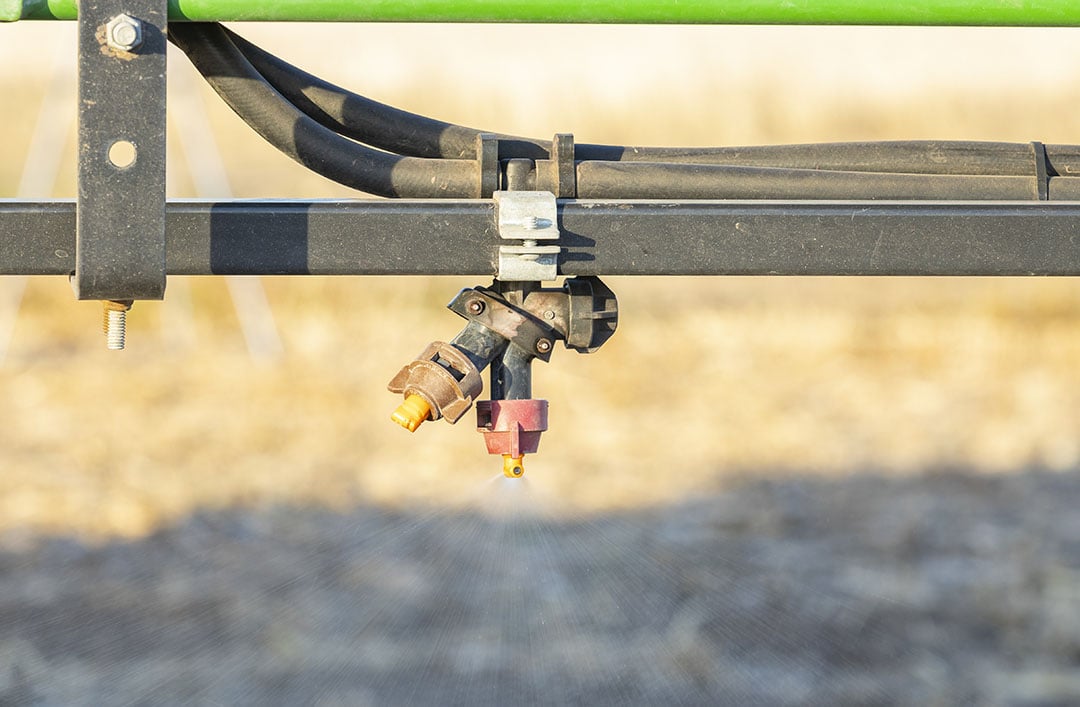
Drift depositions
Results show the drone produced significantly higher ground and airborne spray deposition than the tractor-mounted boom sprayer.
“It is not surprising to find drift from the drone is higher than a boom sprayer. But we found that using a ‘swath offset’, which is commonly used in standard aerial applications, helps mitigate the problem.
“Operators should already know this. They should have the met data for the day and knowing the windspeed at the downwind edge of the field are able to compensate by using a swath offset,” he says.
Swath offset is a technique that has long been recommended for conventional manned fixed-wing and rotary aircraft and incorporated by regulators in pesticide risk assessment to mitigate spray drift. Until now, however, there was no solid research data that documented the application and associated benefits of apply this to drone spraying.
Spray test results compared
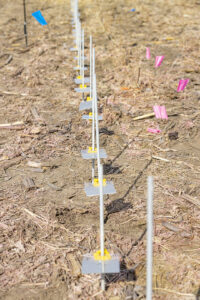
Trial results show employing the swath-offset, to account for displacement of the spray caused by wind-driven off-target movement, could be effective in reducing drift for the drone, particularly when using medium droplet nozzles.
Applications were made with nozzles producing medium and extra coarse spray droplets. Spray drift and deposition were measured out to 100m downwind and airborne drift was determined out to 50m downwind at heights of 0.2m and 2m.
“Regardless of the delivery platforms, overall spray drift was greater from the medium nozzle than that for the extra coarse nozzle. This shows that droplet size is a critical factor governing spray deposition and drift,” comments Dan.
The drone produced significantly higher ground and airborne spray deposition than the tractor-mounted boom sprayer. This applies to both the medium and extra coarse nozzle treatments.
Graphs of the results in the test report compare the air and ground depositions with and without the offset. These track the drift from each to identify the distance at which this is no ‘statistical difference’.
Boom V Drone, medium nozzles. No offset
With the medium nozzle the drift from the boom is largely contained in area around the spray line – out to about 2m, after which no further deposits are detected. With the drone, however, the drift declines at 5m, but 20% of the target application rate was still being detected out to 10m, before the deposits become statistically the same as the boom at 15m.
Medium nozzles boom V drone with 5m swath offset
Offsetting the drone’s flight path upwind by one swath width (5m) resulted in a huge difference in the depositions. As expected, the boom contained the majority of the application within its working swath width. While the drone’s target rate was still deposited up to 20% across a wider area, it matched the boom sprayer from 6.5m and beyond.
Boom V Drone extra coarse nozzles. No offset
The effect of switching to extra coarse nozzles to cut drift is clearly illustrated by this trial, which shows that by 6.5m away from the ‘edge of field’ there was no statistical difference in deposits between the drone and boom. While the boom sprayer contained 60% of the target rate within a narrow 6m swath, about 20% of this for the drone was spread across a wider area, until there was no difference between the two at 6.5m downwind and beyond.
Extra coarse nozzles boom V drone with 3.3m swath offset
Off-setting by one swath width (3.3m) upwind and using extra coarse nozzles produced the best results to mitigate drift, with no statistical difference between the drone and boom applications at 3m. This is essentially is the same downwind result as the boom sprayer.
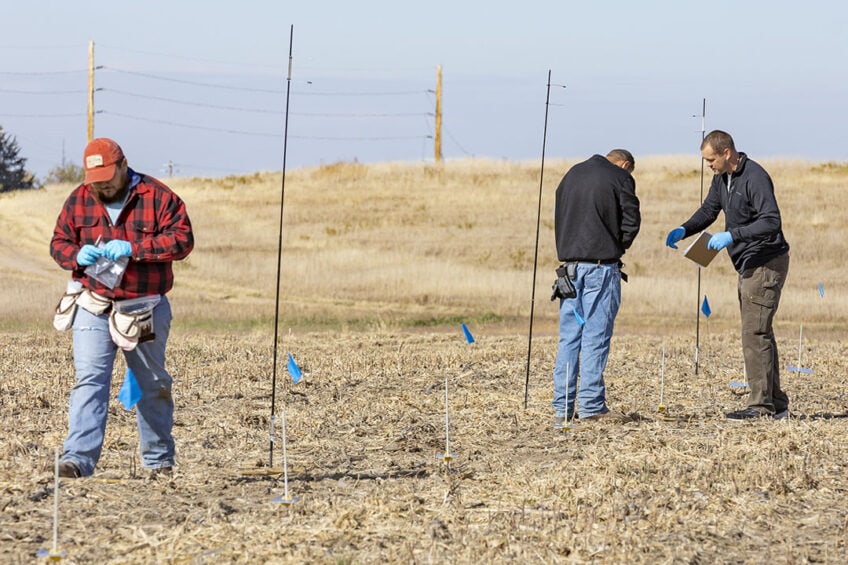
Airborne depositions
Analysis of the results from the ‘bottle brush’ collectors at heights of 0.2m and 2m, showed the airborne spray depositions up to 10m downwind were significantly higher from the drone than the sprayer – with both medium and extra coarse nozzles.
At 10m and beyond, however, there was no significant differences in airborne deposits between the two application methods. There were similar results with the swath offset.
Moreover, the airborne depositions from the medium nozzle halved at the 2m height and at the 0.2m height the these fell by 22%. Results for the extra coarse nozzle with swath offset produced further reductions on the brush samplers of 19% and 22% on the brush samplers at 2m and 0.2m, respectively.
Text continues below picture
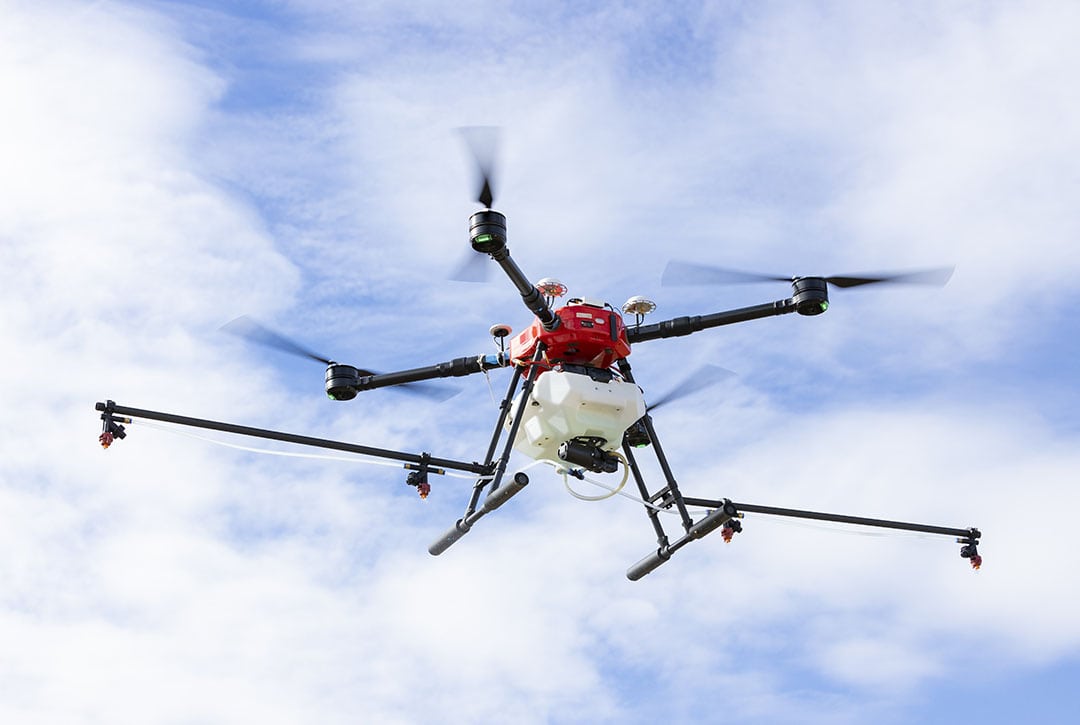
Informing future regulations
Overall, the findings show that proper management of drone applications is important to ensure accurate and effective application and minimise spray drift, explains Dan.
Employing the offset to account for displacement of the spray caused by wind-driven off-target movement is effective in reducing drift for drone spraying – particularly for treatments that require medium droplets.
“Instigating swath offset, with careful consideration of wind speed, proved to be a best management practice for mitigating spray drift for drone applications. Our report, which is currently being peer reviewed, recommends this is taken into consideration in ongoing regulation development on spray drift characteristics,” explains Dan.
“However, the use of swath offset to adjust for displacement of the swath is a relatively novel approach that has not been widely explored in previous drone spraying studies and could be implemented as a best management practice by applicators of this rapidly developing aerial application system.”
Also, as shown by USDA’s previous research, selecting the correct nozzle to make larger droplets can significantly mitigate spray drift from a drone.
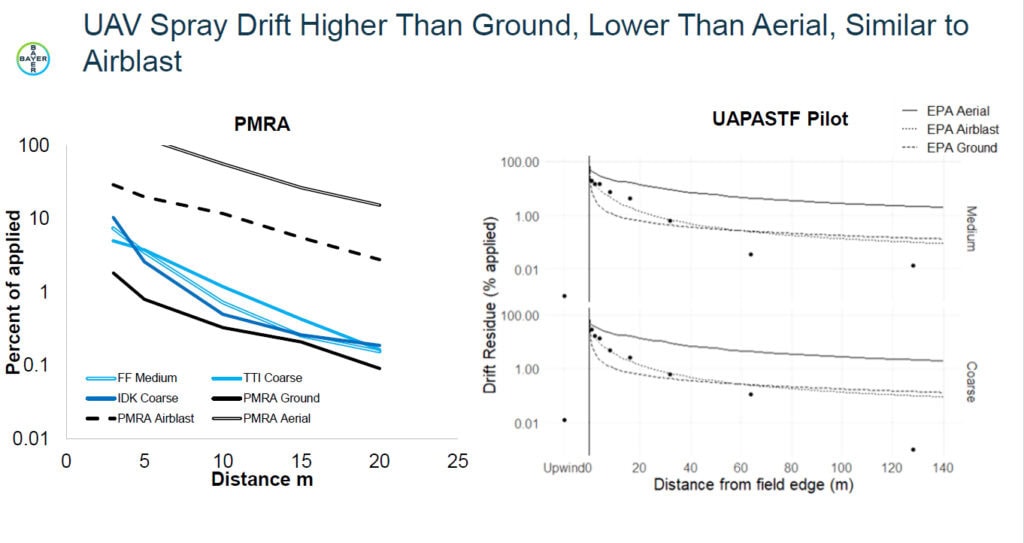
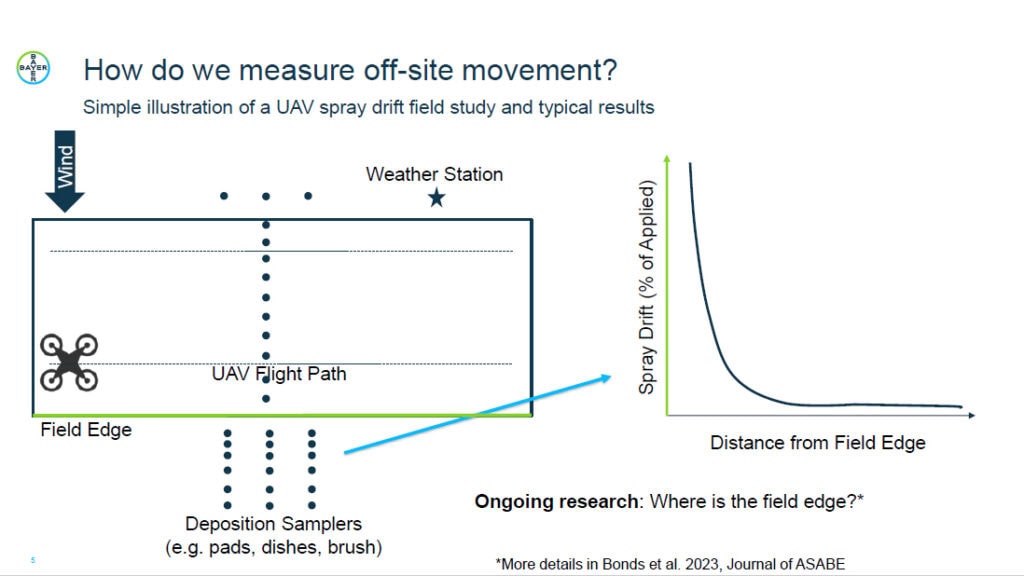
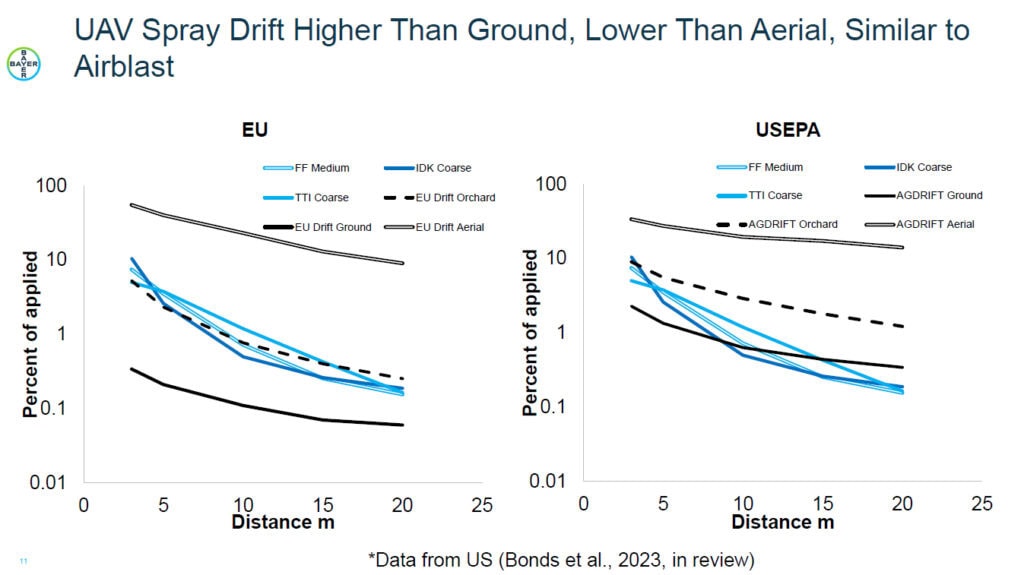
Join 17,000+ subscribers
Subscribe to our newsletter to stay updated about all the need-to-know content in the agricultural sector, two times a week.
